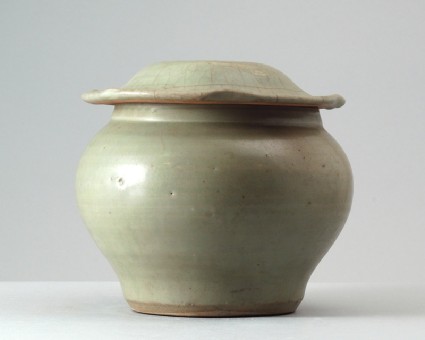The Barlow Collection
A select catalogue of the Barlow collection of Chinese Ceramics, Bronzes and Jades by the University of Sussex (published Sussex, 2006).

Publications online: 456 objects
Greenware baluster jar and lid
- loan
-
Literature notes
In the Yuan dynasty (1279–1368), as vessels shapes became larger and potting sturdier, new techniques were developed to avoid firing cracks and prevent the pieces from warping. The present jar was potted without a base and then closed by attaching a small dish on the inside. This separately potted base is much thinner than the walls of the jar.
This jar was bought together with the lamp, [LI1301.278], which was supposed to fit onto the rim of the jar, but is of different material.
The baluster-shaped jar has a wide rounded shoulder and a splayed neck, and tapers towards the foot which has a broad chamfered edge. The shallow domed cover has a wide flared rim with six foliations, and an incised ring on the top. Otherwise the piece is undecorated. The matt, light green glaze leaves the rim and footring of the jar and the underside of the cover free, the unglazed parts have fired a pale buff to reddish-brown colour. -
Details
- Associated place
-
Asia › China › Zhejiang province › Longquan kilns (place of creation)
- Date
-
14th century (1301 - 1400)
Yuan Dynasty (1279 - 1368)
- Material and technique
- stoneware, thrown, with incised decoration under a green glaze; waster, thrown, with green glaze
- Dimensions
-
17 cm (height)
18.7 cm (diameter)
at foot 12.2 cm (diameter)
- Material index
- Technique index
- Object type index
-
container › vessel › jar › baluster jar,
- No. of items
- 2
- Credit line
- Lent by the Sir Alan Barlow Collection Trust.
- Accession no.
- LI1301.277
-
Further reading
University of Sussex, and Arts and Humanities Research Council, The Barlow Collection, supervised by Regina Krahl, Maurice Howard, and Aiden Leeves (Sussex: University of Sussex, 2006), no. C272
Glossary (3)
glaze, stoneware, waster
-
glaze
Vitreous coating applied to the surface of a ceramic to make it impermeable or for decorative effect.
-
stoneware
Ceramic material made of clay which is fired to a temperature of c.1200-1300⁰c and is often buff or grey in colour.
-
waster
Mis-fired pottery of no commercial value that would probably have been discarded by the potter.
Location
-
- currently in research collection
Objects are sometimes moved to a different location. Our object location data is usually updated on a monthly basis. Contact the Jameel Study Centre if you are planning to visit the museum to see a particular object on display, or would like to arrange an appointment to see an object in our reserve collections.
Publications online
-

The Barlow Collection
In the Yuan dynasty (1279–1368), as vessels shapes became larger and potting sturdier, new techniques were developed to avoid firing cracks and prevent the pieces from warping. The present jar was potted without a base and then closed by attaching a small dish on the inside. This separately potted base is much thinner than the walls of the jar.
This jar was bought together with the lamp, [LI1301.278], which was supposed to fit onto the rim of the jar, but is of different material.
The baluster-shaped jar has a wide rounded shoulder and a splayed neck, and tapers towards the foot which has a broad chamfered edge. The shallow domed cover has a wide flared rim with six foliations, and an incised ring on the top. Otherwise the piece is undecorated. The matt, light green glaze leaves the rim and footring of the jar and the underside of the cover free, the unglazed parts have fired a pale buff to reddish-brown colour.
Notice
Object information may not accurately reflect the actual contents of the original publication, since our online objects contain current information held in our collections database. Click on 'buy this publication' to purchase printed versions of our online publications, where available, or contact the Jameel Study Centre to arrange access to books on our collections that are now out of print.
© 2013 University of Oxford - Ashmolean Museum




